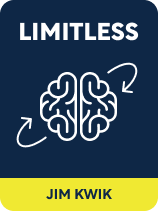

This article is an excerpt from the Shortform book guide to "Limitless" by Jim Kwik. Shortform has the world's best summaries and analyses of books you should be reading.
Like this article? Sign up for a free trial here .
What is exponential thinking? How is it different from incremental thinking?
Too often people think in incremental terms—one step at a time. With exponential thinking, however, each step is bigger than the previous step. It’s an exponential mindset that leads to exponential success.
Read on to learn about exponential thinking.
Limitless Action Starts With Exponential Thinking
In Limitless, Jim Kwik discusses not only how to learn but also how to think. Once you’re capable of learning anything, the next step is using all of your new knowledge to its maximum potential. In other words, Kwik teaches you how to move from limitless learning to limitless action.
Think Exponentially
Kwik urges us to stop thinking incrementally (one small step at a time) and start thinking exponentially (each step bigger than the one before it). According to Kwik, exponential thinking leads to world-changing innovations and billion-dollar companies.
| Entrepreneur Mark Bonchek first wrote about developing an exponential mindset to complement the exponential growth of technology. The crux of his argument was that many businesses fail because they have incremental mindsets in an exponentially advancing world. Bonchek encourages business leaders to make strategies that grow slowly at first, but lead to ever-accelerating rates of return. However, Bonchek’s method claims that you can’t predict the future while using an exponential mindset—he likens an exponential growth curve to a bend in the road that you can’t see beyond. In contrast, Kwik’s model is all about predicting and planning for the future, as we’ll see shortly. |
Exponential thinking encourages us to look beyond the immediate problem and instead seek the root cause of that problem. Solving the underlying issue will most likely have a much greater impact than just fixing the current problem.
1. Find the underlying problem. The problem you’re trying to tackle might not be the real issue at all, so look for a root cause. For example, if you’re trying to reduce air pollution, you might tackle that problem at the source by addressing “dirty” energy sources like coal and oil.
| Kwik urges us to look for root causes, but doesn’t provide much guidance on how to do that. The Design of Everyday Things suggests finding the root cause of a problem by continuously asking “why.” For example, if the problem you’re trying to solve is that you always buy unhealthy fast food on the way home from work, your “root cause analysis” might go something like this: Why am I buying fast food? Because I’m hungry. Why am I hungry? Because I haven’t eaten in a while. Why haven’t I eaten? Because I was at work. Why did being at work stop me from eating? Because I didn’t have food there. Why didn’t I have food at work? Because I didn’t bring any. You could continue with this line of questioning (“why didn’t I bring food to work?”), but the solution to your underlying problem should be clear by now: Bring your own food to work, and you won’t be tempted to buy junk food on the way home. |
2. Ask “what if.” This isn’t just about asking what might happen if you do one thing or another; try to come up with extreme, and even outlandish questions. These seemingly strange questions will get you thinking along different paths than everyday linear thinking would. For example, instead of looking for cleaner energy sources, what if we could make a society that didn’t need electricity at all?
(Shortform note: An article from Forbes offers one reason why “what if” questions can be effective brainstorming tools: they encourage you to approach the situation with an open mind. When you ask yourself “what if,” you let go of your ideas about what’s possible or feasible, and simply try to answer the question.)
3. Study. Now that you’ve found the root problem and thought about some hypotheticals on your own, it’s time to see what other people have to say about that situation. Try to get a well-rounded view of the issue by studying many different (reliable) sources.
(Shortform note: One of the internet’s major pitfalls is that you can find sources supporting any idea or theory you can imagine, no matter how outlandish. Therefore, it’s important to vet your findings, and to take information only from reliable sources. This article from the University of Georgia offers some pointers; most importantly, checking a site’s credibility and the author’s credentials before taking anything on that site as fact.)
4. Imagine what’s next. By now, you should at least have an idea for a solution to the problem you’re tackling. However, before you implement that solution, you should try to envision both the short-term and long-term consequences of it. Note that the short-term consequences might feel like a step back, rather than progress; however, the long-term results of solving an underlying problem will probably go well beyond the immediate issue you were trying to tackle when you started this process.
| Again, Kwik provides a general guideline (imagine the long-term consequences) without offering much concrete advice about how to do it. One Forbes article suggests a five-step process for creating and implementing a long-term plan (while this article is specifically about running a small business, the process applies to any kind of plan): 1) Write down your mission statement. Whether you’re running a business or planning out your personal life, you have a mission that you want to accomplish or a purpose that you want to fulfill. Determine what that is, and write it down. 2) Set goals. Find some concrete objectives or milestones that you’ll meet in the process of fulfilling your mission. 3) Come up with broad strategies. The key word here is broad—you’ll have to deal with the specifics as they arise. However, you should come up with some general strategies and rules of thumb for how you can meet your goals and fulfill your mission. 4) Track your results. Measure what you’re putting into your mission in terms of time, money, resources, and so on, versus what results you’re getting. Be specific: For example, if you’re devoting a lot of time to building your social media presence and aren’t getting as many new followers as you’d like, it may be time to reevaluate that particular strategy. 5) Stay optimistic. Remember that you don’t need to be perfect, and your results don’t need to meet your expectations every step of the way. |
Plan Exponentially
Kwik’s previous model was designed to help us tackle specific problems. However, we plan out courses of action all the time, even when we’re not responding to some dire or complex problem. For example, we might plan the most efficient route to run our errands, or a student might need to plan out what courses he or she will take in the upcoming semester.
Therefore, Kwik encourages you to apply exponential thinking to every plan you make—a practice he calls exponential planning.
- Keep asking, “and then what?” In other words, what would be the consequences of this hypothetical decision? How will you respond to those consequences? What are the consequences of that response? How will you respond to those consequences? And so on.
- Think in different time increments. If you pursue the course of action you’re considering, what will be the results in five days? In five months? In five years?
- Compare your options. For each different option you’re considering, do the deep thinking described in the previous two points. Choose the best course of action based on your conclusions.
Exponential planning is significantly more difficult than short-term, incremental planning. However, Kwik argues, exponential planning gives you insights that other people don’t have; therefore, it allows you to plan for the future much more effectively than others. Kwik promises that, while other people’s situations improve incrementally, yours will improve exponentially—getting you ever closer to reaching your limitless potential.
| Counterpoint: In Antifragile, Nassim Nicholas Taleb repeatedly says that predicting the future is effectively impossible. Furthermore, predictions become less and less accurate the farther ahead they try to look—there are simply too many variables for any model to get an accurate picture of the future. Therefore, rather than trying to predict the long-term outcomes of your actions, Taleb urges you to maximize your options and your flexibility, so that you can take advantage of whatever ends up happening. For example, when a student is applying for college, she shouldn’t just apply to her one favorite school; if that school doesn’t take her, then she’s at a dead end. Instead, she should apply to many different schools—each one that accepts her is another option for the future, and she can then pick her favorite from among those options. |

———End of Preview———
Like what you just read? Read the rest of the world's best book summary and analysis of Jim Kwik's "Limitless" at Shortform .
Here's what you'll find in our full Limitless summary :
- Jim Kwik's guide to meta-learning: learning how to learn
- How to quickly and effectively learn about any topic
- How to use your new knowledge to its maximum potential






